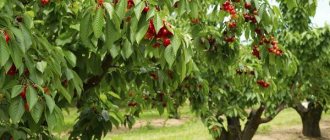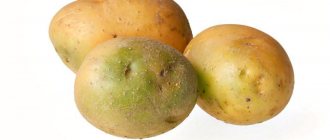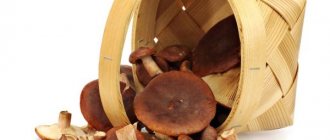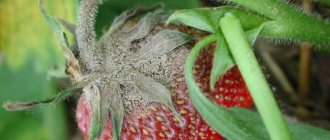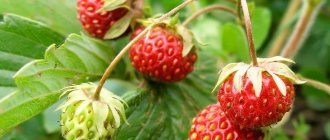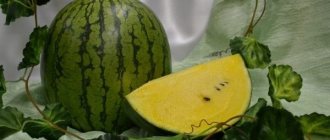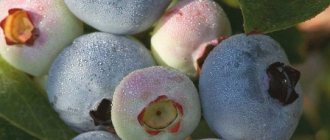We all know that strawberries are a juicy and very healthy summer berry that is loved by both children and adults. In order for the fruits of the universally revered delicacy to be tasty and large, it is necessary to create the most favorable conditions for the plant, and also not to forget about applying fertilizers before the flowering period. Of course, if the strawberry is young and planted a year ago in accordance with all the rules, then there is no need to feed it, because there are already enough useful substances in the soil.
When preparing for the next gardening season, experienced gardeners turn not only to specialized outlets selling fertilizer, but also visit pharmacies. The fact is that drugs such as boron, iodine and potassium permanganate play an important role in feeding plants. How exactly do pharmaceutical products affect the growth and development of strawberries, as well as how to use iodine as a supplement - you will learn about this from the article.
Iodine in gardening
The use of alcohol pharmaceutical iodine composition is a common practice.
There are many recipes: for vegetables, berries, fruit trees, grapes. The product is used mainly as:
- antiseptics (treatment of seeds, seedlings and soil);
- prophylactic drug to prevent the occurrence of fungal diseases (spraying);
- pesticide (planting treatment) to combat worms, aphids, caterpillars and beetle larvae.
At the same time, it is believed that the composition also works as a fertilizer - it stimulates growth, flowering, and activates “vitality”.
Reference! 100 g of standard pharmaceutical solution for external use contains:
- iodine (active ingredient) – 5 g;
- ethyl alcohol – 96.3%;
- Excipients: potassium iodide, purified water.
Preparation of solutions for disease prevention
The use of the drug for the treatment of fungal diseases or various rots is indicated only in the early stages. But as a prophylactic agent (to prevent diseases), iodine is irreplaceable.
How to use:
- disinfection of soil in beds before planting strawberry seedlings. The soil is treated with a solution (3-4 drops of the product are taken per bucket of water). Seedlings are planted no earlier than 8-10 days after treatment;
- against powdery mildew , before the plants begin to bloom, Victoria plantations are sprayed with a simple composition. Dosage - 10-12 drops per bucket of water, plus add whey (1 liter);
- A product containing laundry soap helps prevent gray rot Add shavings (200 grams), a liter of milk or whey, and a teaspoon of 5% iodine tincture to a bucket of water.
Compositions with milk and soap linger better on the leaves and stems of plants, do not drain, forming a protective film.
Application of iodine for strawberries
Directly for garden strawberries, they recommend processing in several stages:
- Soil disinfection in spring or autumn, after removing old tops . Typically, the solution is prepared at the rate of 15 drops of pharmaceutical iodine per 10 liters of water. Sometimes the concentration is increased to 40 drops (10 ml) per 10 l. The drug disinfects the soil and parts of plants affected by diseases, and helps against pests overwintering in the soil.
- Preparing the ground for transplanting young rosettes. A weak solution (3 drops of iodine per 10 liters of water) is poured onto the soil a few days before planting.
- Spring root treatment . Before flowering, strawberry beds can be shed “under the root” with a mixture prepared from 30 drops of pharmaceutical iodine solution, 1 cup of wood ash and 1 teaspoon of boric acid. The ingredients are poured into 10 liters of water, left for several hours and mixed thoroughly. The mixture consumption per bush is 0.5 l. It is used in combination with spraying the above-ground parts of plants.
- Preventative spraying before flowering. The usual way to prepare the mixture is 10 drops per 10 liters of water. The drug is used to combat fungal diseases such as powdery mildew, gray mold, and various spots. Strawberries are processed at least three times, every 10 days, at dusk. You can add milk or whey to the mixture (1 liter per 10 liters).
- Spraying against pests. To 10 liters of water add 30 drops of pharmaceutical iodine solution and 20 g of laundry soap.
The latter mixture should theoretically protect the leaves and shoots of the plant from soft-bodied parasites and beetles, but in practice it does not bring much benefit. There are much more effective remedies, such as infusion of onion peels, tobacco or wormwood. Moreover, iodine vapor can repel beneficial insects, such as bees.
Preventive treatments against insects and diseases
In addition to watering the bushes and soil, spraying the plant has gained great popularity among experienced gardeners. Spraying strawberries with iodine in the spring, due to the excellent antiseptic properties of the substance, can cure the plant of many diseases, and is also used for preventive purposes. There is a separate recipe for each pathology and pest, which has been tested by more than one generation of gardeners on their plantings.
Weevil beetles
Weevils are big fans of strawberries. They overwinter in fallen leaves, and as soon as the temperature rises, the beetle immediately crawls out and begins to feed on the fresh leaves of the plant. To prevent insects from eating strawberry flowers, it is important to treat the bushes before they bloom. To protect against insects, use 7 drops of iodine per 10 liter bucket of water. A thin film forms on the foliage, which repels the weevil beetle.
In the initial stages of the disease, gray mold is effectively combated by spraying the bush with iodine.
Aphid
Aphids are another major problem for strawberry bushes. In early spring, as soon as the snow has melted, water the beds with a solution. Before watering, clear the bed of old leaves and debris, and carefully water and loosen the soil between the bushes of the plant. Some gardeners believe that milk can increase the effectiveness of iodine solution. Therefore, add 1 liter of milk to 10 drops of iodine per 12 liter bucket and mix thoroughly before watering.
Gray rot and red spots
The fight against gray mold and red spots is effective in the initial stages of the disease. In addition to milk, liquid soap is often used. It is also believed to increase the effectiveness of iodine sprays, which are best done in early spring. Add 1 tablespoon of liquid soap to a bucket of iodine solution.
Powdery mildew
This fungus spreads across the leaves of the plant very quickly. It is important to start treatment on time, since in the later stages it is very difficult to cure the bush. The causative agent of powdery mildew is a marsupial fungus, which begins to manifest itself immediately after the spring temperature rises. Spraying the leaves is carried out as early as possible, adding milk to the iodine solution.
Late blight
A strong dose of antiseptics will help in the fight against late blight, so in addition to 20 drops of iodine, add the same number of drops of hydrogen peroxide to a bucket of water. In the fight against late blight, an iodine solution may not be enough, so it is better to use special chemical medications.
Useful properties of the drug
The positive effect of using iodine solution is due to two factors:
- From a chemical point of view, iodine is a halogen, an active substance and a strong oxidizing agent. It reacts with organic and inorganic compounds contained in the soil. At the same time, oxygen is actively released, which is destructive for infections, and a number of substances are formed that stimulate the development of the plant.
- From a biological point of view, this is a microelement necessary for life. It is believed that iodine affects the functioning of plant enzyme systems, resulting in increased yield.
Research conducted at the Uman Agricultural Institute (1930 - 1936) proved that foliar feeding and pre-sowing treatment with potassium iodide accelerates the development and strengthens the immunity of various crops. Early ripening of vegetables and an increase in the content of carotene and other useful substances were noted.
In addition, iodine itself accumulates in fruits and plant matter. Such “enriched” products help to successfully combat thyroid diseases, hormonal disorders and other consequences of iodine deficiency.
Feeding strawberries in the spring: how and when to fertilize
Caring for strawberries begins in early spring, when the snow has just melted. It is spring care that helps the plant recover from winter frosts and prepare well for the next season.
Experienced gardeners first remove covering material from the plantings, remove old leaves, loosen the rows and only then fertilize the strawberries.
In different regions of Russia, fertilizers need to be applied differently. In the southern regions you can start from mid-April. But in the northern regions it is better to wait and feed the strawberries in mid-May.
Affects feeding and flowering time of the plant. If you fertilize late varieties of strawberries too early, the beneficial substances will quickly be washed out and there will be nothing left for the plants during the flowering period. But if you delay feeding early varieties, then the harvest will be insignificant.
Harmful factors
Pharmacy iodine solution is one of the most accessible antiseptics, familiar to everyone since childhood.
This is the only reason that explains the rather frivolous attitude towards such a dangerous drug.
You should always remember that elemental iodine contained in pharmaceutical compositions is a dangerous and very toxic substance.
Its vapors cause irritation of the respiratory tract and mucous membranes, headaches, vomiting, and diarrhea. If the alcohol solution gets on the skin, burns and dermatitis may occur. Severe poisoning can result in death. Chronic poisoning is accompanied by disruption of the digestive tract and nervous disorders.
Carefully! For humans, the maximum permissible concentration of iodine in the air is 1 mg/m3; in water – 0.125 mg/l. A toxic effect for plants is observed at an iodine concentration of 0.5 – 1.0 mg per 1 kg of nutrient solution.
Exceeding the required dosage when treating plants causes a decrease in yield. The color of the leaves changes and their edges curl. The tops of the shoots dry out and the buds fall off. When spraying with a solution that is too saturated, burns may appear - brown spots on the tops.
Strawberry diseases: description and treatment methods
The main factors of strawberry disease:
- Lack of care;
- Planting too dense;
- Precipitation and high air humidity;
- Wrong place to land.
Even if you follow all the rules, the plant may wither. Iodine can come to your aid.
Iodine will help fight strawberry diseases and disinfect the soil and the berries themselves.
Main diseases:
- Powdery mildew;
- White and brown spotting;
- Fusarium wilt.
Strawberry brown spot
Gardeners use traditional methods for treatment:
- Soap-salt solution. Method of preparation: dissolve 40 grams of soap and 50 grams of salt in a bucket of water. Treat the plantations with this solution every week.
- 10 liters of kefir, diluted in one bucket of water , will make whey that can prevent disease. Treat plants three days a week.
- Horsetail tincture (about 100 grams per liter of water). After mixing the ingredients, let it brew for 24 hours. Then boil and dilute with water. Water the plantings for four days.
- Mustard solution (which is prepared from the ratio of 2 tablespoons of powder to 1 bucket of water at room temperature).
- Watering strawberries with iodine and milk . Mixing proportions: 40 iodine drops and 1 liter of milk per bucket of water.
- Potassium permanganate diluted in water.
- A solution of ash (300 grams) infused in 10 liters of water.
- Garlic solution . 400 grams of garlic are infused in a bucket of water.
- Green solution. Ratio: 10 liters of water, 5-7 grams of the drug. What solution is used to treat strawberries with brilliant green twice a month, but only after the fruits bloom.
Previously, we talked about strawberry varieties.
I would especially like to note the usefulness of iodine solutions when germinating strawberries. The drug itself does not cause harm to both the plant and humans.
It creates a protective barrier on the leaves, which, on the contrary, saturates it with vital vitamins and minerals.
Fertilizing strawberries with iodine: in spring and before flowering
The specific effects of iodine-containing preparations on garden strawberries have been little studied.
On the one hand, science says that a microelement is not necessary for the life of a plant.
On the other hand, the experience of several generations of gardeners confirms the increase in yield, improved immunity and other general results of studies conducted for other crops.
However, from the point of view of agrochemistry, it is more rational to use complex formulations in which this element is contained in a highly digestible, soluble form.
Atomic iodine is too active, its behavior largely depends on the composition of water, soil, climatic and other factors. It is assumed that potassium iodide has a positive effect, but its content in the pharmaceutical solution is insignificant.
Microelement content in popular fertilizers recommended for strawberries:
- peat – from 1200 to 31700 mg/kg;
- manure – from 40 to 1000 mg/kg;
- superphosphate – from 0 to 40200 mg/kg;
- phosphate rock – from 150 to 280,000 mg/kg.
Also, high iodine content was noted in floodplain, chestnut and chernozem soils. Red soil is the richest in this element (10 mg/kg).
Does iodine help?
Fertilizing garden strawberries with iodine, according to experienced agronomists and farmers, is not an approved remedy. However, the experience of several generations of gardeners suggests that the use of iodine actually has a positive effect on the growth and development of the plant. The solution is used to combat many problems - dark spots on leaves, fungal infections, uneven color.
Interesting fact
Very often, amateur gardeners who oppose chemicals in the fight for the harvest practice the following method of processing strawberries in the spring: 15 drops of iodine, a glass of kefir or homemade whey from cottage cheese, and a bucket of water. The solution helps eradicate harmful bacteria and fungus. The action is to change the soil environment, and therefore late blight dies.
Fertilizer for strawberries with iodine is used in the spring before the plant blooms. The procedure is usually repeated no more than 2-3 times. Moreover, when using the solution together with phytosporin, summer residents are able to prevent the development of fungus and get rid of this problem.
From a scientific point of view, the suppressive effect of iodine on fungal organisms is difficult to explain, since this hypothesis has not been confirmed by any laboratory experimental studies. One can only assume that since iodine is an antiseptic, it is precisely because of this property that it is theoretically capable of suppressing the development of fungus.
Iodine treatment against diseases and pests
It has been proven that when iodine accumulates in plant cells, it makes them resistant to rot and other fungal infections, and repels nematodes and weevils.
However, in this regard, the effect of the element on strawberries has not been specifically studied.
There is no reason to consider an iodine solution a panacea for any pests. For example, the use of the composition as a contact pesticide that saves from beetles is doubtful, since the active substance cannot remain on the tops for a long time.
It reacts with air and organic matter, is easily washed off with water, and evaporates quickly. The iodine vapor may repel the insects for a while, but they will most likely return.
more successfully on “soft-bodied” pests: aphids, worms, larvae. To destroy wintering individuals, you need to pour a concentrated mixture onto the loosened strawberry beds as soon as the snow melts. Subsequent spraying is more of a preventive measure.
Information that ions from a solution can be “glued” with soap or milk is, to put it mildly, unscientific. It is assumed that lactic acid bacteria actually help the plant absorb iodine during foliar feeding. And laundry soap protects the tops well without any foreign additives.
Important! Any use of iodine is completely excluded from the moment the berry begins to bloom until harvest.
Features of application
Iodine for strawberries can be used not only as a top dressing, but also for the prevention of various diseases. It is especially important to feed the bushes with a solution of the chemical element at the end of March, when the gardener carries out sanitary cleaning of the beds. It is during this period that new leaf plates begin to grow, and the bush needs nitrogen. For better absorption of this element, you will need to add an iodine solution to each plant and systematically moisten the soil. You can add ash extract to the folk remedy for strawberries.
To prepare feeding strawberries with iodine, you will need:
- Pour 300 g of ash into 5 liters of boiling water.
- Add 5-6 drops of iodine to the mixture.
- The solution should sit for 20 minutes.
- After this, you will need to pour 600-700 ml of folk remedy under each bush.
Fertilizer with added ash cannot be stored. The liquid is used immediately after preparation. It should be borne in mind that when using fertilizer for soil treatment, which contains a small amount of nitrogen, it will be difficult to achieve a positive result.
Treatment of strawberries from pests and diseases
Iodine is used by gardeners to treat berry crops from various diseases and pest invasions. It is also advisable to use a folk remedy to prevent strawberry diseases.
To prepare the solution you will need:
- liquid soap – 2 tbsp. l.;
- water – 20 l;
- iodine – 10-15 drops.
Adding liquid soap to the composition of the folk remedy helps improve the consistency of the solution and prevents it from sticking to the leaf plates.
Spraying a berry crop with a similar solution will allow:
- stop or prevent the spread of disease caused by fungal microorganisms;
- apply foliar fertilization of strawberries with iodine;
- repel weevils that cannot tolerate the aroma of antiseptic.
There is an opinion that spraying remontant strawberries with an iodine solution after flowering has completed can cause re-blooming.
Preventive feeding
Often, when planting new planting material, diseases and pests enter the beds. In order to prevent such a nuisance, you should treat the bushes with a folk remedy, the preparation of which will require 15 liters of settled rainwater and 5 drops of iodine. Before planting purchased seedlings, you will need to spill the soil with freshly prepared liquid.
When working with iodine, it is worth remembering its toxic properties, which tend to evaporate easily. You should not start working with the beds immediately after treating them with iodine solution, so as not to inhale toxic fumes.
How to prepare a watering solution
Recipes for iodine-containing formulations are described above, in the paragraph “Using the preparation for strawberries.”
Information about dosage and processing steps is also provided there. Preparing compositions for spraying and feeding is quite simple, but it should be noted that when mixing the ingredients, you cannot use metal tools and utensils - they will oxidize. You can use plastic buckets, ceramics, glass jars, and wooden stirring sticks.
It is not recommended to store solutions. But if necessary, use tightly closed glass containers. The place reserved for storage must be dry, well ventilated and dark. Dampness, heat and direct sunlight contribute to the decomposition of the compounds.
Attention! When working with drugs containing atomic iodine, observe safety precautions and strictly follow the recipe!
Why do strawberries need iodine and boric acid?
Iodine is an antiseptic, it helps get rid of and prevent the occurrence of many diseases. It copes well with fungal formations and bacteria. Strawberry weevil , which often settles on fruits and devours them, does not tolerate the smell of iodine.
Boric acid directly contains the substance Boron, which is very necessary for plants, including strawberries. Boric acid is used both as a fertilizer and to stimulate seed growth. Helps overcome some diseases and even help in the fight against ants. A lack of boron is accompanied by rotting of the root system, the plant develops poorly, and the leaves become irregularly shaped. If there is a deficiency of boron, dry rot, bacteriosis and other diseases may develop. The amount of harvest is directly related to the availability of this substance in abundance. It is believed that treatment with boric acid increases the yield by one third.
How to protect yourself
You need to wear gloves when working with iodine solution in a ventilated area. Avoid contact with skin, eyes or mouth. It is dangerous to inhale iodine vapor.
If your eyes begin to water, your throat becomes sore, or your head begins to spin, stop working immediately and rinse your mucous membranes with cold water. And drink more milk - this is a universal remedy for poisoning with inorganic poisons.
Do not leave medications in places accessible to children or pets, or near flammable substances!
How to properly feed strawberries
In one season, the plant needs three main feedings, which are carried out taking into account the development of the bush.
1. Strawberries are fed for the first time in the spring immediately after winter. In preparation for flowering.
2. The second feeding of strawberries should be done immediately after harvesting. This will help the plant recover from fruiting and replenish its supply of nutrients.
3. The plant is fertilized for the last time in mid-September. This helps the plant gain strength and cope with diseases and pests.
It is imperative to feed strawberries in the spring. It cannot do without additional nutrition in order to produce a good harvest and resist diseases.
Features of spring feeding of strawberries
The procedure has its own characteristics in addition to choosing the right fertilizer. Spring fertilizing is not applied immediately after the snow melts. Once the ground is bare and warm weather arrives, you can start trimming old leaves and damaged tendrils. Also, immediately after the snow layer has melted, remove the mulch or insulation material and loosen the soil. Make sure the cold doesn't come again. It is better to delay the fertilization of strawberries a little, otherwise the plants will get sick in high humidity and severe frosts.
As for the time for feeding strawberries, it may vary depending on the region. For example, in the Moscow region and Ukraine, spring comes earlier than in the Urals and other regions. You should not rely on the weather, as it is deceptive - today the sun will shine, and tomorrow it will snow. In warm regions, just like in cold ones, you can navigate by Easter or the opening of the tourist season. About 10 days before this, you can remove the mulch and trim last year's leaves. Be sure to ensure that frost is not expected.
Only perennial strawberry bushes require additional fertilizing. Early feeding of strawberries in spring is required for those plants that have been growing in the garden for more than 2 years. Annuals do not need to be fed, since they have not yet absorbed all the nutrients added when planted in a permanent place.
The benefits of iodine when planting strawberries and during their flowering period
Before planting young rosettes in the ground, it is recommended to water it with iodine solution. The planting of strawberries itself can be done after 3 or 4 days. You need to fertilize strawberries using the following solution: dilute 3 drops of iodine in a ten-liter bucket of water.
Many people practice feeding strawberries before the flowering period. Fertilizer for this period will be different: dissolve 30 drops of iodine in a ten-liter bucket of water, and also add one teaspoon of boric acid and one cup of ash. Let the fertilizer sit for at least a couple of hours. Then mix the solution thoroughly. You need to fertilize the soil under the strawberry bushes. Each plant needs no more than 500 milliliters of solution.
You can improve this fertilizer for strawberries using laundry soap. The fact is that soap acts as a kind of connecting link, thanks to which iodine evaporates more slowly if you water the plant with it. In this case, the effect of the procedure for strawberries will be greater. After all, the drug will have time to have a positive effect on garden strawberries.
Mixed feeding recipes
- Mix half a teaspoon of boron in 10 liters of warm water, pour in 10 milliliters of iodine (usually 20 ml in a pharmacy bottle) and 2 tablespoons of ash. We do watering. You can first dust the watered strawberries with ash, and then pour a solution of boric acid and iodine from a watering can to wash the ash off the leaves. It would be a good idea to supplement the solution with potassium permanganate.
- We take 2 grams of boric acid, one tablespoon of urea, 2 grams of potassium permanganate and half a glass of ash and dilute it with 10 liters of water and water it.
Potassium permanganate will help sterilize the soil from harmful flora. It will saturate the plants with potassium and help get rid of bacterial and putrefactive diseases such as black leg, root rot, etc.
Ash deoxidizes the soil very well. Fungus and rot grow in acidic soil, because... We introduce ash, then we do prophylaxis against various diseases.

